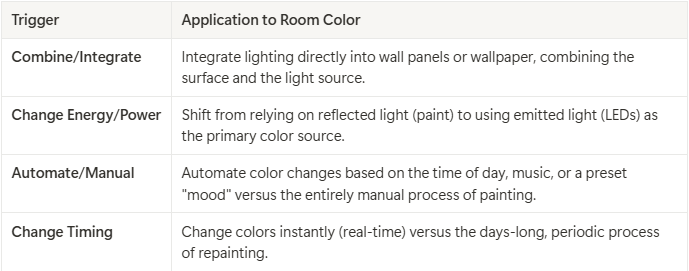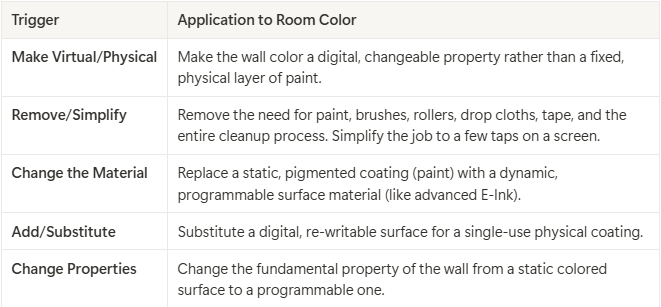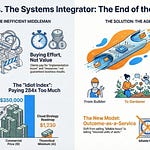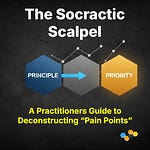Introduction: The Unchanging Job of a Changing Room
Side Note: I’ve actually done this research, and I wasn’t the first one. When I did it, the client didn’t want to hear anything about anything other than paint. It was a waste of research dollars.
You know the feeling. You look around a room in your home—your living room, your bedroom, your office—and you just feel… tired of it. It feels stale, uninspired. You want a change, a refresh, a new vibe. And almost immediately, your mind defaults to one solution, a word that brings with it a cascade of associated thoughts: a trip to the hardware store, the crinkle of drop cloths, the sharp smell of chemicals, and the slow, tedious process of painting.
For centuries, this has been the answer. But what if I told you that painting isn't the answer? What if painting is actually a terrible, inefficient, and frustratingly outdated solution to the real problem you're trying to solve?
The core "Job-to-be-Done," as we call it in innovation strategy, isn't to apply a pigmented liquid to a vertical surface. The real job you're "hiring" paint for is to modify the ambient color of a space to create a desired mood or aesthetic.
That’s it. You’re trying to change how a room feels. Paint is just the clumsy, analog tool we’ve been stuck with.
By focusing on the job itself, separate from the solution, we can uncover radically better ways to get it done. Ways that are faster, cleaner, more flexible, and ultimately, far more powerful. In this post, we're going to deconstruct the job of changing a room's color, explore the deep-seated frustrations with the current method, and then look at the incredible innovations—some available right now and some just over the horizon—that will make the messy, laborious process of painting a thing of the past. It's time to think beyond the brush.
Deconstructing the Core Job: What Are We Really Trying to Accomplish?
Before we can innovate, we have to understand. We need to break down the job of "modifying ambient color" into its component parts to see exactly where the current solution—painting—fails us. This isn't just about the physical act; it's about the entire experience, from the moment you decide you want a change to the moment you can finally enjoy it.
The Functional Job
Let's use a tool called a "Job Map" to break down the functional process of painting a room. A Job Map doesn't describe what you do with a specific product; it describes the universal steps anyone must take to get the core job done.
Define: This is the planning stage. What color do you want? What finish? You have to visualize the outcome. The struggle here is immense. You tape tiny paper squares to the wall, trying to imagine what they’ll look like at ten times the size, in different lighting conditions. You’re trying to predict the future, and the risk of choosing wrong is high.
Locate: Now you gather your inputs. You have to locate the right paint, the right brushes, rollers, trays, tape, drop cloths. This often means a trip to a giant, overwhelming hardware store. Did you forget the primer? Do you have the right kind of roller for your wall texture? The list of potential failure points is long.
Prepare: This is arguably the worst part of the entire process. You have to prepare the room. This means moving furniture, covering everything in plastic, and painstakingly taping every edge, outlet, and trim piece. You also have to prepare the wall itself—cleaning it, patching holes, maybe even sanding. It’s a huge amount of work before you even get to the main event. The mess and disruption to your life have begun, but you haven't made any visible progress toward your goal yet.
Confirm: You're ready to start. You open the can. Is it the right color? You do a test patch. It looks different on the wall than it did on the swatch. You have to confirm that you have everything you need and that you’re ready to commit to this color, because turning back now is difficult.
Execute: You finally apply the paint. This is the core execution step. It's physically demanding. You’re stretching, reaching, trying to maintain a wet edge to avoid lap marks. You’re fighting against drips, splatters, and uneven coverage. It’s a race against the clock before the paint starts to dry. And you almost certainly have to do it all over again for a second coat.
Monitor: While you execute, you’re constantly monitoring your work. Is the coverage even? Did you miss a spot? Did paint bleed under the tape? You’re trying to assess the quality of the job in real-time, often in imperfect lighting, knowing that fixing mistakes later will be a pain.
Modify: You see a drip. You have to modify your technique. You realize you’re running out of paint. You have to modify your plan and make another trip to the store, hoping they can match the color perfectly. The modification process is fraught with friction.
Conclude: The painting is done. But the job isn’t. Now you have to conclude the process. This means cleanup—washing brushes and rollers, disposing of materials. Then you have to wait for the paint to dry, a period of hours or even days where your room is still unusable. Finally, you can peel off the tape (and pray it didn't pull off your new paint) and move your furniture back. The job is only truly "done" when the room is back to its functional state, which can be days after you started.
Looking at this map, it's clear that the current solution is a disaster. It's filled with wasted time, effort, and risk. The actual value-creating step—applying color—is a fraction of the total work required.
The Emotional and Social Jobs
But we don't just undertake this frustrating process for functional reasons. There are powerful emotional and social jobs we're trying to get done, too.
Emotional Jobs: You want to feel a sense of renewal and freshness in your space. You want to express your personal style and creativity. You might be trying to create a calming sanctuary or an energizing workspace. Ultimately, you want to feel proud of your space and enjoy being in it. The frustration of the painting process directly conflicts with these goals. It’s hard to feel serene and renewed when you’re surrounded by mess and stressed about the outcome.
Social Jobs: We are social creatures, and our homes are part of our identity. You may want to impress guests with a stylish and well-kept home. You might be trying to create a better environment for your family, like a fun color for a child's room. You could also be trying to keep up with design trends you've seen online or in magazines.
The problem is, the current solution serves these deeper jobs poorly. The finality of paint creates anxiety. What if the trend you’re following looks dated in two years? What if your guests don't like the bold color you chose? You're locked into your decision by the sheer effort it would take to change it.
Elevating the Abstraction: From "Painting a Wall" to "Controlling Ambient Color"
Here’s where we pivot. The key to true innovation is to stop trying to improve the broken solution (e.g., "paint that dries faster" or "tape that doesn't bleed") and instead, elevate the level of abstraction. We need to stop thinking about painting and start thinking about the real, higher-level job: controlling ambient color.
Paint is a low-level, feature-laden solution. It comes with a massive number of "features" you're forced to deal with: brushes, rollers, trays, drop cloths, fumes, drying times, and the physical properties of liquid adhesion. You have to become a semi-professional painter just to get the job done.
What if the solution was integrated directly into the room? What if it had fewer visible features? What if the color wasn't a physical substance applied to the wall, but a dynamic property of the wall itself?
This is the mental leap. We need to separate the idea of "color" from the idea of "paint." When you do that, you open up a whole new universe of possibilities.
Innovating the Solution: Getting the Job Done Better
Once we're focused on the right job, we can explore new solutions. Let's look at two concepts, one that's an incremental improvement available today, and one that's a revolutionary leap forward.
Concept 1: Dynamic Color Surfaces (Working Today, Underutilized)
The first step away from paint is already in many homes: smart lighting. Systems from Philips Hue, Govee, Nanoleaf, and others allow you to change the color of a room with an app. From a Jobs-to-be-Done perspective, this is a significant improvement. It eliminates the preparation, execution, and cleanup steps entirely. It allows you to monitor and modify the outcome instantly. It perfectly serves the desire for dynamic control.
But it's an incomplete solution. Smart lighting is an overlay. It paints your room with light, but it doesn't change the underlying surface. In bright daylight, your white walls are still white. It’s also dependent on having multiple, often expensive, fixtures to create an even wash of color.
A more integrated approach, and the next logical step, is to embed the lighting directly into the surfaces. Imagine LED panels that look like standard wall panels, or a form of "light-emitting wallpaper." This gets us closer to making the wall itself the source of color.
Let's look at this through the lens of our Creativity Triggers:
This concept gets the job done better and with significantly less effort, but it's still fundamentally about adding light to a room. The true revolution comes when we rethink the surface itself.
Concept 2: The "Digital Paint" Revolution (Novel Concept)
Now, imagine a wall that doesn't need to emit light to have color. Imagine a wall whose surface can change its properties to reflect different colors of ambient light, just like paint, but on command. This is the promise of "digital paint," and the technology is closer than you think.
The key is in reflective display technology, most famously E-Ink, the stuff used in Kindle e-readers. E-Ink works by using tiny microcapsules containing charged black and white particles. Applying an electric field moves the particles to the top or bottom of the capsule, creating a black or white spot. This is what forms the text and images on your Kindle screen.
Crucially, E-Ink is bistable, meaning it requires zero energy to hold an image; it only uses a small amount of power to change it. Now, imagine an advanced, full-color version of this technology manufactured in large, flexible sheets that can be applied to a wall.
This isn't just wallpaper; it's a dynamic, programmable surface.
This solution gets the job done completely differently and far more effectively than any alternative.
It perfectly addresses the desire for dynamic control and personalization. Want a calm blue for reading? Done. A vibrant yellow for a party? Instantly. Want to test a color before committing? See it in real-time, in your actual lighting.
It eliminates virtually every single struggle associated with painting: no planning, no material gathering, no prep, no execution, no monitoring, no cleanup, no drying time.
It has dramatically fewer visible features. There are no brushes, no rollers, no cans, no mess. The entire solution is the wall itself, controlled by an app.
It can do things paint could never do. You could display subtle patterns, textures, or even photorealistic murals. Your wall could become a piece of art, a window to a forest, or a simple, solid color.
Let's run this through the Creativity Triggers:
This is a true innovation. It doesn't just improve the old solution; it makes it obsolete by getting the real, underlying job done in a vastly superior way.
The New Job Performers and Business Models
This kind of disruptive innovation doesn't just change the solution; it changes the entire ecosystem around it.
First, the Job Performer changes. The person getting the job done is no longer a professional painter or a skilled DIYer. With a "digital paint" wall, anyone who can use a smartphone app can be the job performer. The need for specialized skills is completely eliminated, democratizing high-end interior design.
Second, it opens up entirely new Business Models. We can use Doblin's 10 Types of Innovation framework to explore this:
Profit Model: Instead of a one-time sale of paint, companies could offer a subscription service for new patterns, textures, or artist-created "wallscapes." Imagine subscribing to a museum's collection and displaying a different Monet on your wall every week.
Product System: The walls would become part of a larger smart home ecosystem. Your wall color could sync with your smart lighting, your music, and even your calendar. A "focus mode" could turn your office walls a calming green, while a "party mode" could cycle through vibrant colors in time with the music.
Service: While the user experience would be simple, the initial installation would require expertise. This creates a new market for professional installation and integration services, much like electricians or home theater installers today.
This future isn't about selling a product (a can of paint) but about providing an ongoing service (dynamic control of your environment).
Conclusion: Stop Painting, Start Designing
We started with a simple, universal frustration: the hassle of painting a room. But by looking at it through the lens of Jobs-to-be-Done, we uncovered a deeper truth. We don't want to paint; we want to control the feeling of our spaces. We want to be designers, not laborers.
The journey from messy paint cans to smart lighting and, ultimately, to fully programmable "digital paint" walls is a perfect example of how true innovation works. It comes from rigorously deconstructing the customer's struggle and elevating our thinking from improving the old solution to finding a new, vastly superior way to get the real job done.
The future of our homes is one where our environments are as dynamic, personal, and easy to change as the software on our phones. It's a future where we stop painting and start designing.
Now, I want to hear from you. What's one "job" in your home that you feel is still being served by a clunky, outdated solution? Share your thoughts in the comments below.
Follow me on 𝕏: https://x.com/mikeboysen
If you'd like to see how I apply a higher level of abstraction to the front-end of innovation, please reach out. My availability is limited.
Mike Boysen - www.pjtbd.com
Why fail fast when you can succeed the first time?
My Blog: https://jtbd.one
📆 Book an appointment: https://pjtbd.com/book-mike
Join our community: https://pjtbd.com/join














